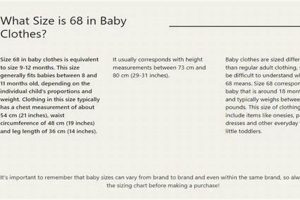The period for which a baby fits into the smallest size of infant apparel is highly variable. Factors such as birth weight, body length, and individual growth rate influence this timeframe. Newborn clothing is typically designed for infants weighing up to approximately eight pounds. However, a larger baby may never wear this size, while a smaller or premature infant might remain in it for several weeks.
Determining when to transition to the next size is important for infant comfort and mobility. Clothing that is too small can restrict movement and potentially cause skin irritation. Monitoring the infant’s weight and length, along with observing how well the clothing fits around the torso and limbs, offers clues regarding the need to upsize. Avoid relying solely on age guidelines provided on clothing labels, as these are averages and do not account for individual variations in growth.
Therefore, while general estimates exist, focusing on the individual baby’s physical development provides the most accurate indicator of when to shift away from the initial clothing size. Parents and caregivers should prioritize comfort and unrestricted movement when selecting apparel for their infant.
Tips
Selecting appropriate infant clothing involves more than just choosing an appealing design. Paying attention to fit and monitoring the infant’s growth are crucial for comfort and safety. Here are some guidelines for managing the transition from newborn-sized garments:
Tip 1: Observe the Fit: Pay close attention to how the clothing fits around the infant’s torso, limbs, and neck. Garments that appear tight or leave marks on the skin indicate a need for a larger size.
Tip 2: Monitor Growth Markers: Track the infant’s weight and length during regular check-ups. These measurements provide objective data to compare with the sizing charts of clothing brands.
Tip 3: Prioritize Comfort: Opt for garments made from soft, breathable fabrics to minimize skin irritation. Avoid clothing with restrictive elastic or embellishments that may cause discomfort.
Tip 4: Consider Seasonality: Adjust clothing choices to suit the prevailing weather conditions. Layering allows for adaptability to changing temperatures and avoids overheating or chilling the infant.
Tip 5: Account for Diaper Space: Ensure there is adequate room for a diaper, whether cloth or disposable. Restricting the diaper area can lead to leaks and discomfort.
Tip 6: Anticipate Growth Spurts: Infants experience periods of rapid growth. Regularly assess clothing fit and prepare for potential size changes to maintain comfort.
Tip 7: Pre-Wash Garments: Wash all new clothing before the initial wear to remove any potential irritants or chemical residues from the manufacturing process.
Effective management of infant clothing relies on vigilance and a focus on the child’s well-being. Regular assessment of fit, combined with an awareness of growth patterns, allows for proactive adjustment and ensures optimal comfort.
Applying these tips will improve the selection process and helps contribute to the infant’s overall comfort and development. Continue to monitor the infant’s individual needs and adjust practices accordingly.
1. Individual infant growth
Individual infant growth patterns are primary determinants in assessing how long an infant wears newborn-sized clothing. Variances in growth rates directly affect the duration for which these garments remain suitable.
- Weight Gain Velocity
The rate at which an infant gains weight significantly influences clothing size. Rapid weight gain necessitates a quicker transition to larger sizes, shortening the period for newborn apparel. Conversely, slower weight gain may extend the time an infant fits into this initial size. Measurement of weight gain velocity can offer a predictive tool for clothing management.
- Linear Growth Rate
Changes in body length are another critical factor. An infant experiencing rapid linear growth may outgrow newborn clothing in length before outgrowing it in weight. Monitoring length, in conjunction with weight, provides a more comprehensive understanding of overall growth and sizing needs.
- Body Composition
Individual differences in body composition, such as the proportion of fat to muscle, can influence clothing fit. Infants with a higher proportion of body fat may fill out newborn clothing more quickly, requiring a transition to a larger size sooner than expected based solely on weight or length. Body composition adds a layer of complexity to size assessment.
- Genetic Predisposition
Genetic factors play a role in determining an infant’s growth trajectory. Family history of growth patterns may provide insights into the anticipated duration for which newborn clothing will be appropriate. While not definitive, genetic predispositions can offer a general guideline.
Understanding the interplay between these facets of individual infant growth is crucial for making informed decisions regarding clothing size. Regular monitoring of weight, length, and observation of overall fit remain essential for ensuring infant comfort and appropriate attire.
2. Birth weight variation
Birth weight variation is a primary determinant of the duration for which an infant wears newborn-sized clothing. Infants born at a lower weight, typically considered premature or small for gestational age, are more likely to remain in newborn clothing for an extended period. This is due to the sizing of newborn garments being designed for infants up to a specific weight range, generally around eight pounds. An infant weighing significantly less than this benchmark will necessitate a longer utilization of this size to accommodate their physical dimensions. In contrast, infants born at a higher weight, approaching or exceeding the upper limit for newborn clothing, may bypass this size altogether or only wear it for a very brief period.
The causal relationship between birth weight and clothing size duration is straightforward: lower weight extends the use of smaller sizes, while higher weight shortens it. This relationship is crucial for parents and caregivers to understand, as relying solely on age-based sizing guidelines can lead to discomfort and ill-fitting garments. For instance, a full-term infant born weighing nine pounds may immediately require clothing designed for 0-3 months, while a premature infant weighing five pounds may remain in newborn attire for several weeks until reaching a comparable weight and size. The ability to accurately gauge birth weight in relation to standard clothing sizes enables more appropriate and comfortable dressing practices.
In summary, birth weight variation has a direct and measurable impact on how long an infant wears newborn clothing. Understanding this correlation allows for informed purchasing and dressing decisions, promoting infant comfort and well-being. While individual growth patterns subsequently influence clothing needs, birth weight serves as a critical initial indicator of the anticipated duration for newborn clothing usage.
3. Clothing brand sizing
Clothing brand sizing significantly impacts the duration for which a baby wears newborn clothes. Sizing variations across different manufacturers introduce inconsistencies in the actual dimensions of “newborn” garments. A “newborn” size from one brand may be comparable to a “0-3 months” size from another, leading to premature abandonment or delayed adoption of specific sizes. This discrepancy stems from a lack of standardized sizing conventions within the infant apparel industry. The consequence is that the nominal age range or weight recommendation on the label becomes an unreliable indicator of actual fit. Consequently, the duration a baby wears newborn clothes is not solely determined by their growth but is also contingent on the specific brand and its sizing practices. Practical significance lies in the need for parents and caregivers to assess clothing fit empirically, rather than relying solely on labels.
A practical example illustrates this variability: An infant weighing 7.5 pounds might comfortably fit into a “newborn” onesie from Brand A but find the same size from Brand B too snug. Conversely, the same infant may require a “0-3 months” size from Brand C to achieve a similar level of comfort and mobility. These variations necessitate a more hands-on approach to clothing selection, often involving physical comparison of garments or reliance on customer reviews that address sizing discrepancies. Further complicating matters is the potential for sizing variations within the same brand, either due to manufacturing inconsistencies or design changes across different product lines. The clothing material (stretchable fabric) and garment design may change the size duration.
In summary, clothing brand sizing introduces a layer of complexity to determining how long a baby wears newborn clothes. The absence of uniform standards necessitates a focus on practical assessment of fit and awareness of brand-specific sizing tendencies. While individual infant growth remains a primary factor, the influence of clothing brand sizing cannot be overlooked. This understanding is crucial for optimizing comfort, avoiding unnecessary purchases, and managing infant apparel effectively.
4. Infant's body shape
The shape of an infant’s body influences the duration for which newborn clothing remains suitable. While weight and length provide general guidelines, the proportional distribution of weight and dimensions significantly impacts how well a garment fits. Infants with a longer torso, for example, may outgrow newborn onesies in length before they reach the weight limit specified for that size. Conversely, an infant with a shorter torso but a broader chest may find newborn clothing constricting in the chest area while the length remains adequate. These variations in body shape necessitate a more nuanced approach than solely relying on weight or age labels.
Specific anatomical characteristics further affect clothing fit. Infants with relatively larger heads may experience difficulty with newborn-sized neck openings, even if the body of the garment fits appropriately. Similarly, an infant with proportionally thicker thighs may find newborn pants or leggings too tight around the legs, limiting mobility and causing discomfort. In these instances, a larger size may be required to accommodate these specific body features, even if other measurements fall within the newborn range. Real-life examples of this involve parents finding that while the clothing technically ‘fits’ according to weight guidelines, their child is clearly uncomfortable due to tightness in certain areas like the chest, legs, or around the neck.
In summary, the duration of newborn clothing usage is not solely determined by weight and length, but is significantly influenced by the individual infant’s body shape and proportions. Paying attention to these anatomical variations and prioritizing comfort over adhering strictly to size labels ensures optimal fit and allows for a more accurate determination of when to transition to larger clothing sizes. Challenges arise in the absence of standardized sizing that accounts for these shape variations, underscoring the importance of careful observation and practical assessment by caregivers.
5. Comfort & Mobility
The duration for which a baby wears newborn clothing is directly linked to the infant’s comfort and mobility. As an infant grows, newborn clothing may become restrictive, hindering natural movements such as kicking, stretching, and rolling. The limitation of these movements can lead to discomfort, fussiness, and potentially impede motor skill development. Clothing that is too tight around the torso, limbs, or neck can compromise circulation and cause skin irritation. Therefore, the decision to transition from newborn clothing should prioritize maintaining an optimal level of comfort and unrestricted movement for the infant.
Real-life examples illustrate this connection. An infant who frequently pulls at their clothing, exhibits redness or chafing in areas where the garment is snug, or consistently resists being dressed may be signaling that the clothing is no longer comfortable. Caregivers might observe a decrease in spontaneous movement or increased irritability when the infant is wearing newborn clothes. Practical application involves regularly assessing the fit of clothing, paying particular attention to ease of movement and any signs of discomfort. Choosing garments with flexible fabrics and designs that accommodate a full range of motion can extend the period of comfortable wear. However, once restrictions become apparent, a transition to larger sizes becomes necessary to prevent negative impacts on the infant’s well-being.
In summary, comfort and mobility serve as crucial indicators for determining when to transition from newborn clothing. Ignoring these signs can compromise the infant’s physical comfort and potentially hinder motor development. Regular assessment, combined with a focus on unrestricted movement, ensures that clothing choices support the infant’s growth and well-being. The challenge lies in balancing the desire to maximize the use of smaller sizes with the imperative to prioritize the infant’s comfort and developmental needs, demanding vigilant observation and proactive adjustments.
Frequently Asked Questions
This section addresses common queries regarding the period during which an infant typically wears newborn-sized clothing. The provided information aims to clarify factors influencing this timeframe and offer practical guidance.
Question 1: Is there a specific age range for wearing newborn clothes?
No absolute age range exists. Newborn clothing is designed for infants within a specific weight and length range, typically up to 8 pounds and 21 inches. Individual growth rates dictate the duration of use, irrespective of age.
Question 2: How does birth weight affect clothing size duration?
Infants born at a lower weight generally remain in newborn clothing for a longer period. Conversely, larger infants may quickly outgrow this size or bypass it altogether.
Question 3: Do all clothing brands have the same “newborn” size?
Sizing inconsistencies exist across different clothing brands. A newborn size from one brand may differ significantly from another. Empirical assessment of fit is advisable.
Question 4: What signs indicate it’s time to transition from newborn clothes?
Signs include clothing appearing too tight, restricted movement, skin irritation, and the infant consistently pulling at the garments. Comfortable fit and unrestricted mobility are essential indicators.
Question 5: How does an infant’s body shape impact clothing fit?
Body shape influences clothing fit. Infants with longer torsos or broader chests may require larger sizes sooner than weight and length alone would suggest. Focus on anatomical fit, and not solely on size labels.
Question 6: Is it harmful for an infant to wear clothing that is too small?
Yes. Clothing that is too small can restrict circulation, cause skin irritation, and hinder motor development. Prioritize properly fitted garments.
In conclusion, understanding the variables impacting newborn clothing duration allows for informed decisions and ensures infant comfort. Observation of individual growth patterns, awareness of brand sizing variations, and emphasis on comfortable fit are paramount.
The subsequent section will explore tips for selecting appropriate infant clothing sizes.
How Long Does a Baby Wear Newborn Clothes
This exploration clarifies that the duration of newborn clothing use is not determined by a fixed timeline. Multiple factors, including individual growth rates, birth weight, clothing brand sizing variations, and the infant’s body shape, contribute to the variability in this period. Assessment requires monitoring the infant’s weight, length, and comfort levels, as well as consideration of the garment’s fit relative to the baby’s anatomy. Reliance solely on age-based sizing is discouraged due to inconsistencies across brands and individual developmental differences. The goal is to prioritize unrestricted movement and avoid discomfort.
Accurate determination of the appropriate clothing size necessitates careful observation and a proactive approach. Parents and caregivers benefit from understanding the various influences impacting clothing fit, enabling them to make informed purchasing decisions and ensure the infant’s well-being. Continuous assessment remains essential throughout infancy, adapting to evolving growth patterns and anatomical changes to maintain comfort and support healthy development.







